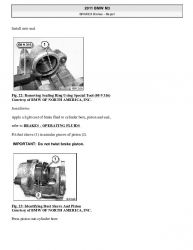BMW M3 1985-2013 Workshop Repair & Service Manual
Catalog:
Model:
Complete repair service manual contains service, maintenance, and troubleshooting information for the BMW M3 1985-2013. Diagnostic and repair procedures are covered in great detail to repair, maintain, rebuild, refurbish or restore your vehicle like a professional mechanic in local service/repair workshop. This cost-effective quality manual is 100% complete and intact as should be without any missing pages. It is the same factory shop manual used by dealers that guaranteed to be fully functional to save your precious time.
This manual for BMW M3 1985-2013 is divided into different sections. Each section covers a specific component or system and, in addition to the standard service procedures, includes disassembling, inspecting, and assembling instructions. A table of contents is placed at the beginning of each section. Pages are easily found by category, and each page is expandable for great detail. It is in the cross-platform PDF document format so that it works like a charm on all kinds of devices. You do not need to be skilled with a computer to use the manual.
M3 (E30) 1985-1992
M3 (E36) 1992-1999
M3 (E46) 2000-2006
M3 (E90/E92/E93) 2007-2013
EXCERPT:
2011 BMW M3 - BRAKES Brakes - Repair
34 00... CHECKING BRAKE DISCS
Necessary preliminary tasks
Remove WHEELS .
Checking thickness difference:
Measure thickness difference within brake surfaces at 8 point (spread over the circumference) with a
micrometer gauge
Compare measurement result with SETPOINT VALUE
Fig. 7: Checking Brake Surface Thickness Using Micrometer Gauge
Check minimum brake disc thickness:
Position special tool 34 1 280 GAUGE at three measuring points in area (1) and measure.
Compare measurement result and lowest value with SETPOINT VALUE
Fig. 8: Checking Minimum Brake Disc Thickness Using Special Tool 34 1 280
34 00 009 CHECKING BRAKES ON TEST STAND
Necessary preliminary tasks
Check tires for damage
Check tire treads
Checking tire inflation pressure
IMPORTANT: The corresponding system must be deactivated on vehicles equipped with ASC+T or DSC. The ASC+T or DSC telltale and warning light must light up in the instrument cluster!
Fig. 9: Checking Brakes On Test Stand
The brakes must be at normal operating temperature. To do so, gently warm up the brake disks and brake drums while dry by braking the vehicle several times.
IMPORTANT: Only brake test stands with test speeds of 2.5-6 km/h may be used. Max. bedding-in time 2 minutes. You must follow without fail the guidelines contained in the operating instructions of the relevant test stand manufacturer. Failure to do so may result in damage to the vehicle and the system and also personal injury.
34 00 513 CHECKING PARKING BRAKE SETTING (VEHICLE CHECK FOR SERVICE)
IMPORTANT: Follow instructions for BRAKE TESTING ON TEST STAND .
NOTE: If deviations are identified during the following check, the parking brake must be adjusted:
0th tooth (handbrake released):
Vehicles with manual transmission: Shift lever in neutral position.
Vehicles with automatic transmission: Selector lever in "N" position.
Without locking differential < or = 150 N.
With locking differential < or = 200 N (possibly odd display).
1st tooth: No increase in braking force with regard to 0th tooth. Indicator lamp can be lit.
2nd tooth: Indicator lamp must be lit.
3rd tooth: Increase in braking force.
5th tooth: The brake force display must have reached > or = 400 N.
Checking brake force differential at wheel:
Apply handbrake until a wheel circumferential force (measured on brake test stand) of min. 1000 N is reached. Max. permitted brake force differential right/left < or = 35 % (referred to greater brake value).
It must be possible to brake with locked wheels with the handbrake.
34 00 010 CHECKING THICKNESS OF BRAKE PAD
...





